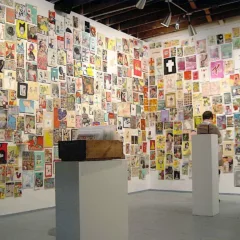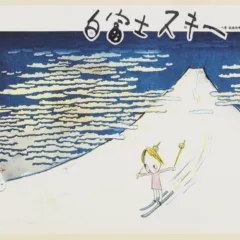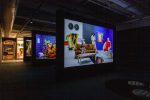Does contemporary art swing from one pole of “everything” to its opposite of “nothing”? This very casual notion stems from two French artists, Yves Klein and Arman. In the late 1950s Klein famously exhibited “Le Vide” (The Void), an empty space “sensitized” by the artist, at Iris Clert’s gallery in Paris. About a year later, Arman countered with “Le Plein (The Full-Up), filling the gallery with a ton of garbage. (Arman’s sardine can souvenir multiples from the show can be seen here). This year’s Foire Internationale d’Art Contemporain (FIAC) (October 21 -24) dances around this idea in ways probably unknown to most dealers, with “everything” winning out, as few collectors undoubtedly have much patience with nothing, and even fewer artists do “nothing” particularly well.
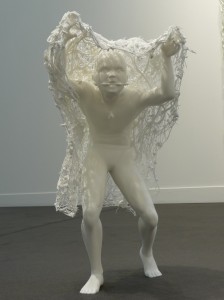
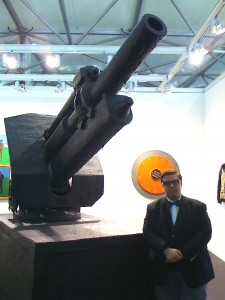
So upon entering the Cour Carrée part of the FIAC, cozily situated in a big tent in the Louvre’s square courtyard, one is immediately confronted with a massive gun, perhaps a howitzer, aptly titled WWII by Atelier Van Lieshout. The 2010 cannon in polyurea (300 x 140 x 335 cm), dripping with a tar-like paint, is a unique piece: a dirge of sorts on war and aesthetics. And of course, we all love big guns, don’t we? The affable Theo-Mario Coppola of Jousse Enterprise Paris, gives me the tour of the weapon. “No, it’s not iron,” he says. “It’s like styrofoam.” I think it’s an interesting welcome work for the fair, but not overly friendly. Coppola, on the other hand is perhaps the friendliest person working behind the stands at the fair (and he’s only an intern!), speaks a handful of languages, but knows his “nothing,” too. Pointing myself in the direction of the cannon, I lock and load to make my rounds.
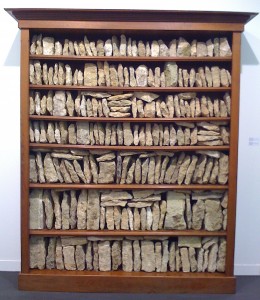
I’m struck by the endless array of weird, artist-designed objects (painted motorcycles, cinder block archways, a drum set painted black, a monster-style slide and swing set, an immense bookshelf filled with rocks, a giant fiberglass banana protesting happily with a tomato sign, a collection of singing and jiggling bricks) all vying to become the FIAC mascot of the year. Hmm…maybe Cyrill Hatt’s stapled Mickey Mouse sculpture is the ticket? However, these works all fight with one of the most persistent images at the stands: the ever-busy art dealers and their teams pounding away at their MacBooks, apparently sending off e-mails to interested collectors. Sure. Even though the WiFi has been down all day and no one can get on the net under this tent. So, as the dear reader probably knows, visitors to art fairs are routinely ignored. (A strange kind of nothing to be sure). It seems that most of the important sales have been made, and wearing a baseball cap doesn’t advance my cause to get some conversation going. I offer a polite “Excuse me…?” in English. The maniacally-typing dealers barely look up to acknowledge my presence.
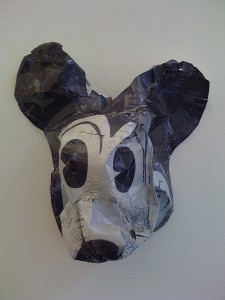
While looking at the photo-op ready Banane by Bruno Peinado at Loevenbruck Gallery, I strike up a conversation with a girl admiring the banana. I ask her about her tag and she tells me she is working with Sylvie Amar at the Galerie de Marseille’s booth. “You must see the work of Matthew Briand,” she says. She adds that it’s amazing and … all sold out. The sculptures are quite something – technically flawless and technologically so new (to me, at least), I wonder how these dozen or so Escher-like towers and figures, and skulls suspended from the ceiling with fishing line, are produced. “Briand uses 3-D drawings and the works are assembled with lasers based upon this software,” explains dealer Sylvie Amar. There are towers of men climbing stairs, a lynching taking place in a skull, a puzzle of hundreds of well-defined mice and other pieces that are nothing less than spires of fairy tale puzzles. Seemingly constructed out of a single sheet of paper, Briand’s pieces are both fragile and powerful; one suddenly feels like a giant in their presence, and a man with a back pack nearly smashes into one. They not only echo Escher, but a touch of Harry Potter’s Hogworts, and exude a brand of fantasy much more compelling than the banana.
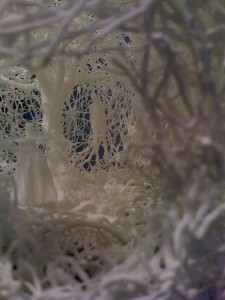
Justin Matherly, who builds abstract concrete figures that spill over their aluminum walkers, crutches and commodes is happy to tell me about the sculpture he produced for the FIAC in the Jardin des Tuilleries. “The experience was very strange for a first trip to France to be locked in a warehouse in the Paris suburb Vitry-sur-Seine the whole time,” he says, exhausted. Matherly, who lives in New York, says he spent 10 days constructing what he calls The Belevdere Torso (Why don’t you put your beautiful head between your legs, where your reason sits among the lice of your debauchery and the running sores of your depravity, 2010) for the Tuilleries (which was sold). The piece in the Bureau-Inc space at the Cour Carrée is typical of this artist’s longtime interest in “ambulatory products.”
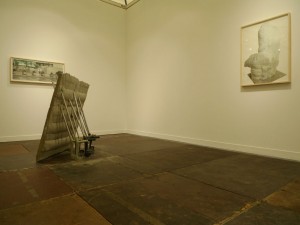
His rough concrete wall comes up to one’s belly button, and is buttressed by a cadre of aluminum crutches. Matherly’s art brut constructions are poetic send-ups of the human form with a little help from the medical industry; but they’re not silly. There’s a vague whiff of Robert Gober about them (a stretch, I know) and a kind of DIY aesthetic, too, that rings true. They also look great on the raw wooden crate floor. “Is there a premium for the warehouse style?” Bureau-inc dealer Gabrielle Giattino says “No,” but adds she could have had the carpet for the same price. She says the wood with its beat-up look, edged in bruised metal, was more her gallery’s style. Playing the clown, I say: “I thought it might have been imported…as an art piece, a kind of nothing piece, an invisible Carl Andre….”
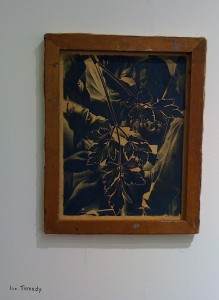
Ian Tweedy’s drawings in pencil and ink on the backs of canvases and scraps of paper at Monitor, a Rome-based gallery, give me pause. Beautifully done, but rough enough to seem like genuine efforts at getting (literally) at the strange structure of images, I find myself poring over this young American’s work for quite a while. One senses the effort and intelligence in these works – delicate but aggressive reworkings of printed materials on a variety of supports.
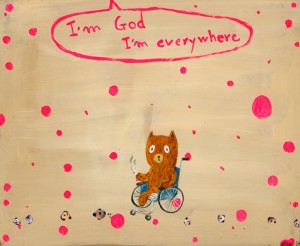
Similarly, Atsushi Kaga‘s clever painted drawings/cartoons, pull me in immediately for different reasons. Clever, funny, irreverent, these small works on canvas or board arranged in an ensemble or in a line on a wall, fall in between David Shrigley and Yoshitomo Nara, and take Hello Kitty to art hell and back. Kaga’s dopey, lonely bunnies rowing in the dark, or others produced like Grateful Dead posters (“A World Without You Is Fucking Brilliant“) in magic marker, pen and watercolors, or pathetic care bears in wheelchairs gazing forlornly into space with their amputated legs and smoldering cigarettes, like “I’m God I’m everywhere” (2009), just kind of break your stupid heart.
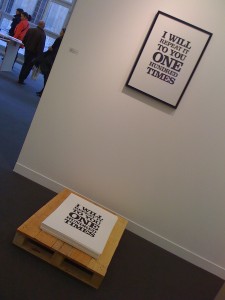
The work by Diego Santomé at Madrid-based gallery, Parra & Romero interested me for what it wasn’t: A work by Felix Gonzalez-Torres, the late Cuban artist whose installations of candy piled in a corner or prints stacked high on gallery floors were nibbled away as visitors removed them piece by piece. Santomé’s “I will repeat it to you 100 times,” a 2010 unique piece of 100 silkscreen images (one framed, 99 stacked on a crate), evokes Gonzalez-Torres, but is more interested, perhaps, in purchase than participation. I wonder openly to the Parra & Romero dealer what would happen if a collector purchased the work, then distributes each of the 100 prints to friends, or resells them. “They would destroy the piece,” he says. “Would they?” I’m not so sure.
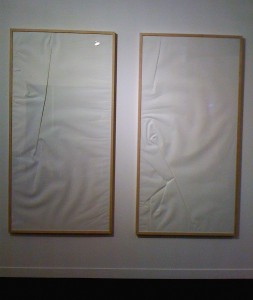
Of course, there’s still quite a lot of nothing here, as well, as my terrible photo of a diptych nothing by Fabien Giraud & Raphaël Siboni testifies. Their Sans titre (Untitled, 2010), is composed of compressed Arches 300 gram paper, an action accomplished by squeezing it into their frames. This DIY piece was offered by Loevenbruck Gallery, and met my medium level standard for “nothing.” Regardless, I did like it, and will possibly try this at home, irreverent philistine that I am.
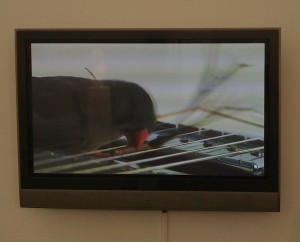
No FIAC is complete without the totally watchable video. Céleste Boursier-Mougenot’s Les Oiseaux de Céleste (Céleste’s Birds, 2008), a piece produced for the installation From Here to Ear, fascinates with the hard rock rhythms of birds picking away at an electric guitar. Right out of Christian Marclay’s playbook, the video is simple and utterly absorbing, and the sounds emanating from this bird band are deliriously wonderful for the full 7 minutes. Boursier-Mougenot’s work touches often upon music, sound and the odd visuals she creates to produce them. She should be picked up by MTV. More of her work here, from Galerie Xippas Paris.
To get the flavor of the Cour Carrée space, which I do like, one should note that all art aisles lead to the café where a show of new Ricard pastis in rainbow flavors (green, yellow, orange, reddish…I don’t know what the flavors are) is currently being beta-tested with the art crowd, along with the limited edition Heineken aluminum beer can-bottle hybrid. When I see people quaffing these down, I’m wondering “Why are they drinking milk?” Limited edition? I liked it, sure, but not enough to squirrel it away in my collection.
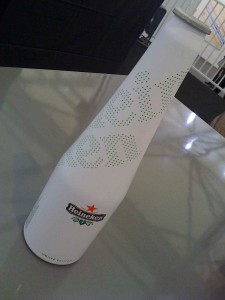
Like most people window shopping here, I enjoy the compression of the FIAC…and the odd collage of works invading your view as you mosy, and isn’t this the point of the art fairs anyway? It’s like the Internet! A recent debate – Art Fairs Are About Money Not Art was posted on the Saatchi Gallery website and focuses largely on the Frieze. And some of its commercial, critical and artist proponents and detractors get in a few swings including Frieze director, Matthew Slotover, Simon de Pury, Sir Norman Rosenthal, Jasper Joffe, Matthew Collings and Louisa Buck. It’s longish, but well worth the time to read . Click here to view. Art fairs have always been about art and money, and most dealers will say that without the art fairs, surviving on local sales is impossible.
Clearly the art fairs are here to stay, and the larger ones like the FIAC, along with Frieze and Art Basel, draw crowds that don’t buy anything but rather plop down their $20 to get a sense of what’s out there, and what kind of world we live in. And yet there’s always that funny competition that rises up among artists who nearly break the backs of their dealers in the go-go art market that is also on display at the fairs. Case in point: the exhibition card for David Kramer from Galerie Laurent Godin, a Paris space which just launched a show of the artist’s work entitled, “Untitled (Because I am Not Richard Prince….).” One of Kramer’s pieces on view, not exactly a Prince knock-off, comes pretty close. There’s some kind of tongue in cheeky joke here. See the exhibition card for yourself:
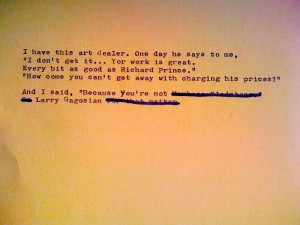
My art browsing only took me to the Cour Carrée and not the Slick Art Fair nestled on the esplanade at the Trocadero, and not to the Jardin du Tuilleries where a number of sculptural installations lined the gorgeous walk ways through the trees; not to the newbie fair, Cutlog at the Bourse, and finally not to the other half of the FIAC at the gorgeous 19th century wrought-iron masterpiece, the Grand Palais, where the more expensive art works were on offer. Perhaps I’m suffering from art exhaustion. (As the FIAC launches, there are no less than 109 exhibitions on view, with 54 gallery openings). Clearly the Paris fair season is expanding in all directions at once in an effort to capture the city and hold it hostage while protesters swell the streets and block fuel depots in an effort to preserve their retirement benefits at age 60. But folks had no trouble jamming into the opening of Larry Gogosian’s new space in Paris to admire Cy Twombly’s expensive, painted scribbles “Camino Real,” or Jean Prouvé’s elegant constructions in tin and wood; or jamming into the Paris style shop, Colette, to see Dan Colen’s “En Grêve” (On Strike, 2010), his pile-up of the omnipresent Velib bicycles in a collaboration with Gogosian. More of everything. Seems an apt metaphor for the art fairs in general.
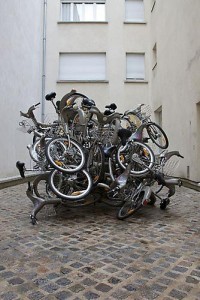
Want more? Enjoy this video from ARTE, the Franco-German television channel: Arte: FIAC PARIS 2010


